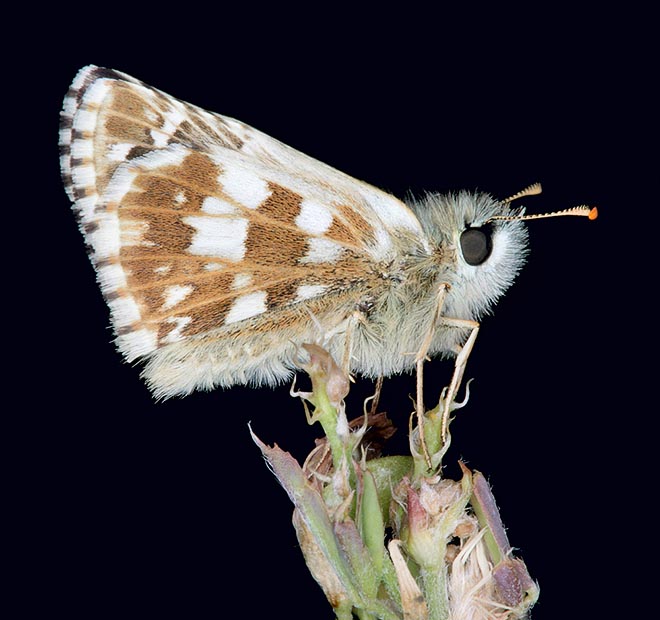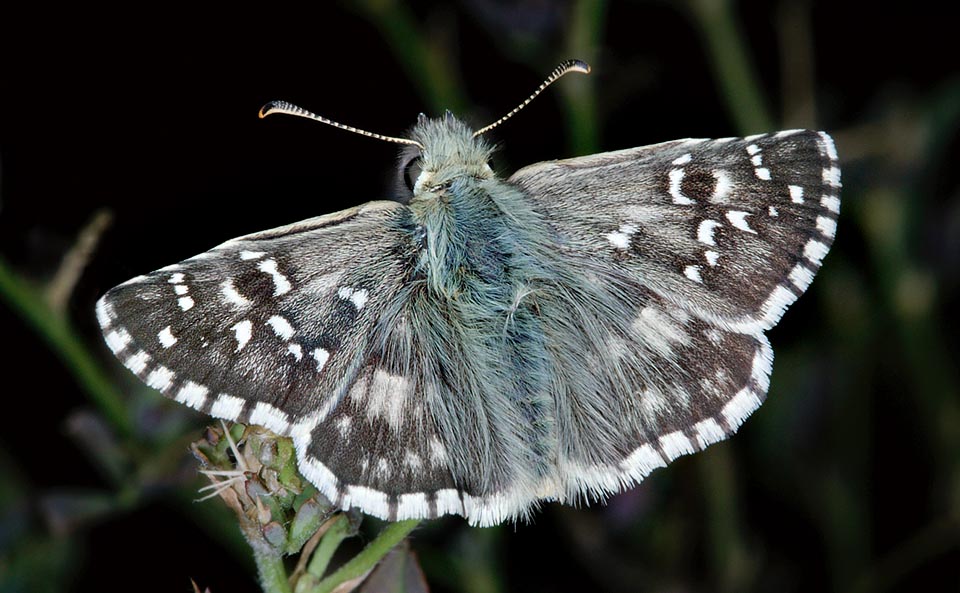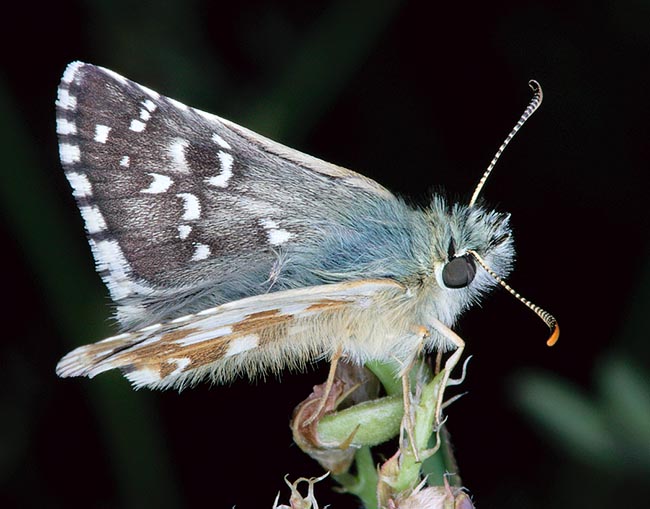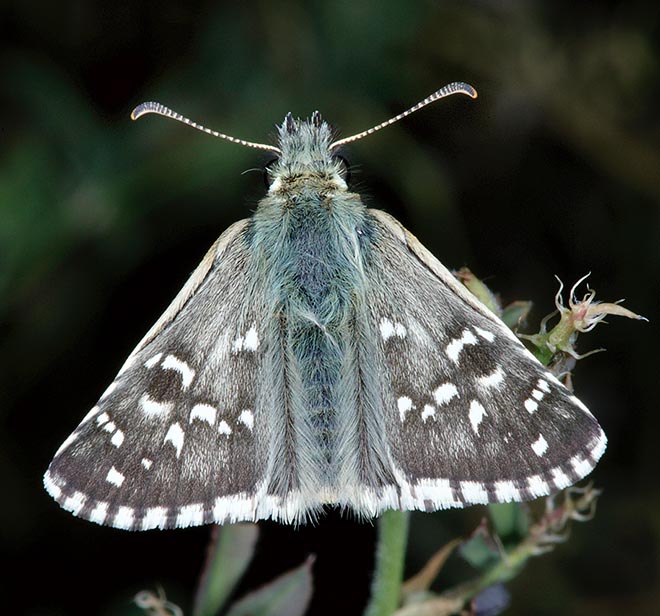Family : Hesperiidae

Text © Dr. Laura Farina

English translation by Mario Beltramini

Like a small tower, hence maybe the generic name, this Pyrgus armoricanus surveys its territory © Giuseppe Mazza
The small Oberthür’s grizzled skipper (Pyrgus armoricanus Oberthur, 1910) belongs to the great order of the Lepidoptera and to the family of the Hesperiidae.
The name of the genus comes from the Greek “pyrgos” meaning “tower, fortress”. The specific name indicates the fact that the species was thought to be native to Armorica, a coastal region of Gaul corresponding roughly to today’s Brittany including the coastal zone between the rivers Loire and Seine. ‘Armoar’ is a word of Celtic origin meaning ‘coast, land on the sea’.
Here are some vulgar European names: Oberthür’s Grizzled Skipper in English; Pirgo bretone in Italian; l’Hespérie des potentilles in French; Zweibrütiger-Würfel-Dickkopffalter in German; Jagodnjakov slezovček in Slovak.
Zoogeograhy
Morocco and Algeria: central range of the Atlas from 1500 m to 1800 m of altitude; Iberian Peninsula, Sardinia, Corsica, Sicily, from France (excepting the North-West and the North-East) to Denmark (Sjælland and Bornholm), south of Sweden (S Skåne), Balkans, Greece (including Kithira and Crete) and Turkey. The species is present all over Italy.
Ecology-Habitat
Pyrgus armoricanus is present from about 500 m to 1700 m of altitude. The species loves frequenting arid meadows, clearings and grassy fallows. However, it can be found also in well sunny humid meadows and rich of flowers.

Has a 26-28 mm wingspan, loves arid meadows, clearings and grassy fallows between 500-1700 m of altitude. Adults are very attracted by Thymus and Achillea flowers © Giuseppe Mazza
The caterpillar nourishes of Wild strawberry (Fragaria vesca), or of various species of Potentilla (P. argentea, P. recta, P. hirta), Globularia and Helianthemum.
The adult butterfly is particularly attracted by the flowers of Thymus and of Achillea.

Present in most Europe, Morocco and Algeria, is locally menaced by the territory urbanization © Giuseppe Mazza
Morpho-physiology
Pyrgus armoricanus is a small butterfly (wingspan included between the 26 and 28 mm) with wings of brownish colour with white zones. The female is similar to the male, but with white spots on the smallest forewings. In the males is present along the fore border of the forewing a fold of the alar membrane that forms a characteristic pocket.
Pyrgus armoricanus is similar to other two species belonging to the same genus. The first is the Pyrgus malvoides, from which distinguishes as having on the right of the hindwings some white spots veiled grey, whilst in the Pyrgus malvoides they are neat. The second similar species is the Pyrgus onopordi.
In North-West Africa lives the Pyrgus armoricanus maroccanus bigger and with more developped spots. In southern Greece, at Kithira and in Crete and Turkey the Pyrgus armoricanus persicus Reverdin, that distinguishes from the type species due to small differences in the males genitalia.
Reproductive Biology
The butterfly has up to three annual generations. It hibernates at the state of chrysalis. The female lays the eggs one by one under the leaves of the host plant. The eggs are spawned from late May to September.

Three annual generations at expense of wild strawberries and species of Potentilla, Globularia and Helianthemum © Giuseppe Mazza
The egg is spherical and strongly flattened, of pale green colour. It becomes grey just before the hatching of the caterpillar. It shows a series of dark brown dorsal bands, and some paler longitudinal bands; the head is black.
During the first stage of its development the caterpillar eats the lower face of the leaf thus creating some “small windows”. Once reached the second stage it builds a shelter wrapping the edges of a leaf with the help of silk threads. In the following stages this involucre becomes more complicate, in such a way to assume an ovoid inner shape. When the caterpillar has reached its maximum development, with silk threads and leaves it builds a shelter inside where will take place the chrysalis.
During the first stage of its development the caterpillar eats the lower face of the leaf thus creating some “small windows”. Once reached the second stage it builds a shelter wrapping the edges of a leaf with the help of silk threads. In the following stages this involucre becomes more complicate, in such a way to assume an ovoid inner shape. When the caterpillar has reached its maximum development, with silk threads and leaves it builds a shelter inside where will take place the chrysalis.
The adult flies in May, July and in September-October. The species is considered as locally endangered. In Europe it stands in serious decrease due to the progressive urbanization of the territory. In 1940 the Italian entomologist Ruggero Verity described it as “one of the most diffused species and, in many sites, most abundant in all Italy, islands included”. Nowadays it is fairly abundant only in some sites.
→ For general notions about the Lepidoptera please click here.
→ To appreciate the biodiversity within the BUTTERFLIES please click here.
